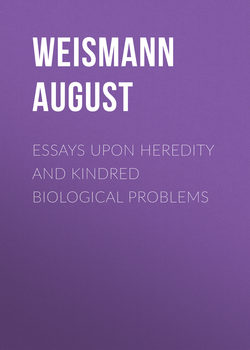Essays Upon Heredity and Kindred Biological Problems

Реклама. ООО «ЛитРес», ИНН: 7719571260.
Оглавление
Weismann August. Essays Upon Heredity and Kindred Biological Problems
AUTHOR’S PREFACE
EDITORS’ PREFACE
I. THE DURATION OF LIFE. 1881
THE DURATION OF LIFE. PREFACE
I. THE DURATION OF LIFE
APPENDIX
Note 1. The Duration of Life among Birds
Note 2. The Duration of Life among Mammals
Note 3. The Duration of Life among Mature Insects
I. Orthoptera
II. Neuroptera
III. Strepsiptera
IV. Hemiptera
V. Diptera
VI. Lepidoptera
VII. Coleoptera
VIII. Hymenoptera
Note 4. The Duration of Life of the Lower Marine Animals
Note 5. The Duration of Life in. Indigenous Terrestrial and Fresh-water Mollusca
Note 6. Unequal Length of Life in the two Sexes
Note 7. Bees
Note 8. Death of the Cells in higher Organisms
Note 9. Death by Sudden Shock
Note 10. Intermingling during the Fission of Unicellular Organisms30
Note 11. Regeneration
Note 12. The Duration of Life in Plants
Note 13
II. ON HEREDITY. 1883
ON HEREDITY. PREFACE
II. ON HEREDITY
III. LIFE AND DEATH. 1883
LIFE AND DEATH. PREFACE
III. LIFE AND DEATH
IV. THE CONTINUITY OF THE GERM-PLASM. AS THE FOUNDATION OF A THEORY OF HEREDITY. 1885
CONTINUITY OF THE GERM-PLASM, &c. PREFACE
IV. THE CONTINUITY OF THE GERM-PLASM AS THE. FOUNDATION OF A THEORY OF HEREDITY. Introduction
I. The Germ-plasm
II. The Significance of the Polar Bodies
III. On the Nature of Parthenogenesis
NOTE
V. THE SIGNIFICANCE OF SEXUAL REPRODUCTION. IN THE THEORY OF NATURAL SELECTION. 1886
SIGNIFICANCE OF SEXUAL REPRODUCTION, ETC. PREFACE
V. THE SIGNIFICANCE OF SEXUAL REPRODUCTION. IN THE THEORY OF NATURAL SELECTION
APPENDICES
Appendix I. Further considerations which oppose Nägeli’s. explanation of transformation as due to internal causes199
Appendix II. Nägeli’s explanation of adaptation202
Appendix III. Adaptations in Plants213
Appendix IV. On the supposed transmission of acquired characters217
Appendix V. On the Origin of Parthenogenesis227
Appendix VI. W. K. Brooks’ Theory of Heredity229
VI. ON THE NUMBER OF POLAR BODIES AND. THEIR SIGNIFICANCE IN HEREDITY. 1887
ON THE NUMBER OF POLAR BODIES AND THEIR SIGNIFICANCE IN HEREDITY. PREFACE
VI. ON THE NUMBER OF POLAR BODIES AND THEIR. SIGNIFICANCE IN HEREDITY
I. Parthenogenetic and Sexual Egg
II. The Significance of the Second Polar Body
III. The Foregoing Considerations Applied To the Male Germ-Cells
IV. The Foregoing Considerations applied To Plants
V. Conclusions with regard to Heredity
VI. Recapitulation
VII. ON THE SUPPOSED BOTANICAL PROOFS. OF THE. TRANSMISSION OF ACQUIRED CHARACTERS. 1888
VII. ON THE SUPPOSED BOTANICAL PROOFS. OF THE. TRANSMISSION OF ACQUIRED CHARACTERS
VIII. THE SUPPOSED TRANSMISSION OF. MUTILATIONS. 1888
VIII. THE SUPPOSED TRANSMISSION OF. MUTILATIONS
Отрывок из книги
The attention of English biologists and men of science was first called to Professor Weismann’s essays by an article entitled ‘Death’ in ‘The Nineteenth Century’ for May, 1885, by Mr. A. E. Shipley. Since then the interest in the author’s arguments and conclusions has become very general; having been especially increased by Professor Moseley’s two articles in ‘Nature’ (Vol. XXXIII, p. 154, and Vol. XXXIV, p. 629), and by the discussion upon ‘The Transmission of Acquired Characters,’ introduced by Professor Lankester at the meeting of the British Association at Manchester in 1887,—a discussion in which Professor Weismann himself took part. The deep interest which has everywhere been expressed in a subject which concerns the very foundations of evolution, has encouraged the Editors to hope that a volume containing a collection of all Professor Weismann’s essays upon heredity and kindred problems would supply a real want. At the present time, when scientific periodicals contain frequent references to these essays, and when the various issues which have been raised by them are discussed on every occasion at which biologists come together, it is above all things necessary to know exactly what the author himself has said. And there are many signs that discussion has already suffered for want of this knowledge.
A translation of Essays I and II was commenced by Mr. A. E. Shipley during his residence at Freiburg in the winter of 1884. His work was greatly aided by the kind assistance of Dr. van Rees of Amsterdam, to whom we desire to express our most sincere thanks. The translation was laid aside until the summer of 1888, when Mr. Shipley was invited to co-operate with the other editors in the preparation of the present volume; the Clarendon Press having consented to publish the complete series of essays as one of their Foreign Biological Memoirs.
.....
The wild goose must live for upwards of 100 years, according to Naumann (l. c., p. 127). The proof of this is not, however, forthcoming. A wild goose which had been wounded reached its eighteenth year in captivity.
Swans are said to have lived 300 years(?), (Naumann, l. c., p. 127).
.....